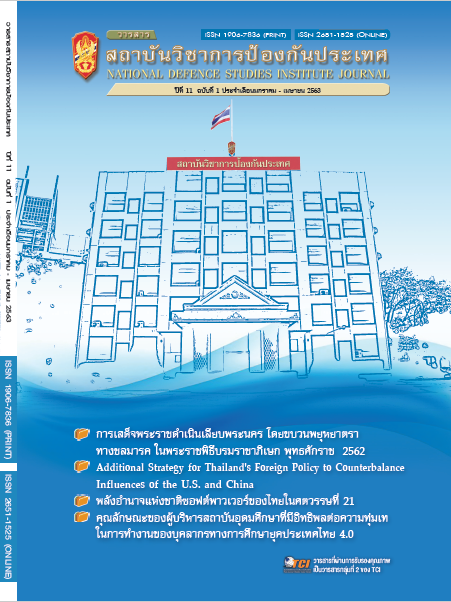Additional Strategy for Thailand’s Foreign Policy to Counterbalance Influences of The U.S. and China
Main Article Content
Abstract
In this new era of U.S.-China competition, Thailand needs to establish a more nuanced or nimble
foreign policy for an effective hedging strategy that can protect and advance its interests as well as
avoid being dictated to by the U.S. and China. Through documentary research, this article investigates
how the existing engagement with other major powers helps Thailand to counterbalance the influence
of China and the U.S., and also explores if there would be future potential for developing more
effective policy through greater engagement with other major powers, middle powers, and multilateral
mechanisms. This study finds that the future regional competitions among the major powers will likely
intensify and Thailand will retain its geopolitical importance so that Thailand needs to diversify its
foreign relations by strengthening relations with other major and middle powers, while also deepening
its engagement with multilateral institutions, with first priority placed on greater economic engagement
and second priority on greater security cooperation.
Article Details
The articles, images, tables, graphs, written content, and opinions published in this journal are solely those of the authors and do not necessarily reflect the views or positions of the National Defence Studies Institute or its academic affiliates.
References
Australian Embassy. (2018). Australia-Thailand relationship, Australian Embassy in Bangkok. Retrieved August 3,
, from http://thailand.embassy.gov.au/bkok/relations.html
Bank of Thailand. (2018). 'Statistics of International Trade: Export and Import merchandise goods'.
Retrieved September 12, 2018.
Bokarev, D. (2017). 'Russia-Thailand Relations Move to a New Level'. Retrieved August 3, 2018, from
https://journal-neo.org/2017/10/21/russia-thailand-relations-move-to-a-new-level/
Busbarat, P. (2016). 'Bamboo swirling in the wind': Thailand’s foreign policy imbalance between China and the
United States'. Contemporary Southeast Asia, 38(2), 233-57.
Chinwanno, C. (2009). Rising China and Thailand’s Policy of Strategic Engagement. NIDS Joint Research
Series, (4). Retrieved from
http://www.nids.mod.go.jp/english/publication/joint_research/series4/series4.html
Cordesman, AH. (2019). China and the United States: Cooperation, Competition, and/or Conflict. Retrieved
December 24, 2109, from
https://www.csis.org/analysis/china-and-united-states-cooperationcompetition-andor-conflict
International Institute for Strategic Studies (IISS). (2016). IISS Shangri La Dialogue 2016. Retrieved August 3,
, from https://issuu.com/iiss-publications/docs/shangri-la-dialogue-2016
Japan Ministry of Foreign Affairs. (2018). Japan-Thailand Summit Meeting. Retrieved July 29, 2018,
from https://www.mofa.go.jp/s_sa/sea1/th/page4e_000291.html
Ministry of Foreign Affairs (MFA). (2015). Ministry of Foreign Affairs Strategy 2015-2018. Retrieved July 29, 2018,
from http://www.mfa.go.th/main/en/policy/58465-MFA%E2%80%99s-4-year-Strategy.html
Parameswaran, P. (2017). 'US Approves New Thailand Military Sale Under Trump', The Diplomat. Retrieved July
, 2018, from https://thediplomat.com/2017/08/us-approves-new-thailandmilitary-sale-under-trump/>
Pejsova, E & Stanley-Lockman, Z. (2018). Japan’s policy shift: arms and transfers, European Union Institute for
Security Studies (EUISS). Retrieved August 3, 2018,
from https://www.iss.europa.eu/sites/default/files/EUISSFiles/Alert%2041%20Japan.pdf
Prasirtsuk, K. (2017). An Ally at the Crossroads: Thailand in the US Alliance System. Retrieved August 3, 2018,
from http://press-files.anu.edu.au/downloads/press/n2504/pdf/ch08.pdf
Storey, I. (2015). Thailand's post-coup relations with China and America: more Beijing, less Washington/
Ian Storey, Trends in Southeast Asia. Singapore: ISEAS-Yusof Ishak Institute:Singapore
Tow, WT & Stuart, DT. (2015). The new US strategy towards Asia: adapting to the American pivot, New York:
Routledge.
Zawacki, B. (2017), Thailand: shifting ground between the US and a rising China/Benjamin Zawacki, Asian
arguments. London: Zed Books Ltd.


